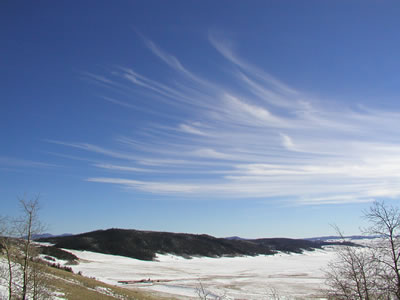Click on image for full size
Ronald L Holle
Clouds are Clues to Climate!
News story originally written on August 13, 2002
Cirrus clouds are thin wisps made of millions of tiny ice crystals that form high in the sky, above the other clouds. These clouds may look harmless because they don't cause big thunderstorms or drop tons of snow, but these little wispy clouds may be clues to how Earth's climate is changing.
Looking at the clouds from above with satellites, NASA scientists found that there are more cirrus clouds around the world than usual. Scientists suspect that more cirrus clouds form when the Earth is warmer. Because global warming is raising the temperature of the Earth's surface over tens and hundreds of years, more cirrus clouds form today than several years ago.
However, not only does climate affect the cirrus clouds, but the clouds can also affect the changing climate. They may warm Earth by acting like a blanket trapping heat rising from the planet. Or, they may cool Earth by acting like a sun umbrella blocking light from reaching the planet's surface.
To understand the composition and structure of the clouds, scientists will make measurements of cirrus clouds from many different levels in the atmosphere, from near the Earth's surface up to 70,000 feet in altitude, as well as looking at the clouds from above with satellites. Hopefully their research will help us better understand how cirrus clouds may change Earth's climate in the future.















